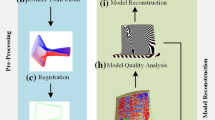Abstract
The remanufacturing technology of aero-engine blade is one of the effective ways to save expensive materials such as titanium alloy, make full use of resources, and solve the problem of resource hiding. Laser-cladding technology has been widely used in the remanufacturing of blades due to its ability to fabricate high-performance alloy surfaces on metal substrates without affecting the properties of the matrix. In order to solve the problem that the grinding precision is difficult to guarantee due to the deformation and residual distribution of the blade in laser cladding remanufacturing, the self-adaptive grinding process of abrasive belt is repaired based on online inspection and reconstruction model. Firstly, the distribution of theoretical measuring points is planned based on the curvature of cross-section curve, and then the theoretical measurement points are adaptively extracted according to the improved firefly algorithm, so that the CMM measurement path planning of laser cladding and remanufacturing blades is realized. Taking the layer as the unit, the measurement data are processed, and the iterative nearest point algorithm is used for data registration to realize the laser-cladding remanufacturing blade measurement data processing. On this basis, the blade surface model is obtained based on NURBS interpolation. Finally, a laser cladding and remanufacturing blade of an aero-engine was tested. The experimental results show that the blade surface roughness is 0.4 μm, the blade edge accuracy is less than 0.05 mm, and the blade edge error is less than 10%. The experimental results show that this method can effectively solve the grinding process of laser-cladding remanufacturing blade.
Similar content being viewed by others
References
Huang Y, Xiao GJ, Zou L (2016) Current situation and development trend of polishing technology for blisk. Acta Aeronautica et Astronautica Sinica 37:2045–2064
Xu BS, Dong SY, Zhu S, Shi PJ (2012) Prospects and developing of remanufacture forming technology. J Mech Eng 48:96–105
Wang L, Wu J, Li T, Wang J, Gao G (2015) A study on the dynamic characteristics of the 2-DOF redundant parallel manipulator of a hybrid machine tool. Int J Robot Autom 30:184–191
Huang H, Gong ZM, Chen XQ, Gong ZM (2003) SMART robotic system for 3D profile turbine vane airfoil repair. Int J Adv Manuf Technol 21:275–283
Huang H, Gong ZM, Chen XQ, Zhou L (2002) Robotic grinding and polishing for turbine-vane overhaul. J Mater Process Technol 127:140–145
Whitton S (2003) Adaptive robot grinding improves turbine blade repair. Industrial Robot: An International Journal 30:1–6
Zhao YH (2015) Research on laser cladding repaired and subsequent processing characteristics of KMN steel compressor blade. Shandong University
Qian N, Ding WF, Zhu YJ (2018) Comparative investigation on grindability of K4125 and Inconel718 nickel-based superalloys. Int J Adv Manuf Technol 97:1649–1661
Wang JW, Yu TY, Ding WF, Fu YC, Bastawros AF (2018) Wear evolution and stress distribution of single CBN superabrasive grain in high-speed grinding. Precis Eng 54:70–80
Xiao GJ, Huang Y (2016) Equivalent self-adaptive belt grinding for the real-R edge of an aero-engine precision-forged blade. Int J Adv Manuf Technol 83:1697–1706
Xiao GJ, Huang Y, Yin JC (2017) An integrated polishing method for compressor blade surface. Int J Adv Manuf Technol 88:1723–1733
Zhao Y, Zhao J, Zhang L, Qi LZ (2009) Robotic blade grinding based on reverse engineering. Journal of Jilin University (Engineering and Technology Edition) 39:1176–1180
Zhang JF, Shi YY, Lin XJ, Duan JH (2017) Freestyle belt polishing technology for leading and trailing edges of aero-engine blade. Acta Aeronautica et Astronautica Sinica 38:247–255
Lin XJ, Yang Y, Wu G, Gao Y, Chen Y, Liu M, Liu MX (2015) Flexible polishing technology of five-axis NC abrasive belt for blade surface. Acta Aeronautica et Astronautica Sinica 36:2074–2082
Yang JH, Zhang DH, Wu BH, Zhang Y, Luo M (2015) A path planning method for error region grinding of aero-engine blades with free-form surface. Int J Adv Manuf Technol 81:717–728
Wang JT, Zhang DH, Wu BH, Luo M, Zhang Y (2015) Kinematic analysis and feedrate optimization in six-axis NC abrasive belt grinding of blades. Int J Adv Manuf Technol 79:405–414
Volkov DI, Koryazhkin AA (2014) Adaptive belt grinding of gas turbine blades. Russ Eng Res 34:37–40
Calleja A, Alonso MA, Fernández A, Tabernero I, Ayesta IL, López de Lacalle ALN (2015) Flank milling model for tool path programming of turbine blisks and compressors. Int J Prod Res 53:3354–3369
Li BK, Ding WF, Yang CY, Li CH (2019) Grindability of powder metallurgy nickel-base superalloy FGH96 and sensibility analysis of machined surface roughness. Int J Adv Manuf Technol. https://doi.org/10.1007/s00170-018-3117-0
Xi XX, Yu TY, Ding WF, Xu JH (2018) Grinding of Ti2AlNb intermetallics using silicon carbide and alumina abrasive wheels: tool surface topology effect on grinding force and ground surface quality. Precis Eng 53:134–145
Zhang BT, Gao FR, Yao K (2016) Neural network and adaptive algorithm-based fractional order sliding mode controller. Control Theory & Applications 33:1373–1377
Xu XK, Wang L, He ZQ, Xu WJ, Lin J (2010) An adaptive power control algorithm based on noncooperative game theory. Journal of Beijing University of Posts and Telecommunications 33:135–139
Zhang XD, Xiong J, Wang CL (2007) Adaptive fuzzy control based on genetic algorithm organizing information. J Xi'an Jiaotong Univ 41:838–861
Wen SP, Zhao GP, Cai KK (2009) A fuzzy-control adaptive algorithm with variable domain. Control Theory&Applications 26:265–268
Acknowledgments
This work was supported by the National Natural Science Foundation of China (grant no. 51705047), the Technological Innovation and Application Demonstration of Chongqing (cstc2018jszx-cyzdX0061), the Fundamental Research Funds for the Central Universities (2018CDQYCD0038), and the major projects of aero-engines and gas turbines (2-2017-VII-0002).
Author information
Authors and Affiliations
Corresponding author
Additional information
Publisher’s note
Springer Nature remains neutral with regard to jurisdictional claims in published maps and institutional affiliations.
Rights and permissions
About this article
Cite this article
Xiao, G., Huang, Y. Surface reconstruction of laser-cladding remanufacturing blade using in adaptive belt grinding. Int J Adv Manuf Technol 101, 3199–3211 (2019). https://doi.org/10.1007/s00170-019-03489-5
Received:
Accepted:
Published:
Issue Date:
DOI: https://doi.org/10.1007/s00170-019-03489-5




